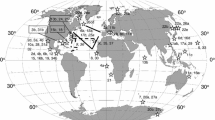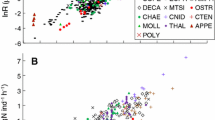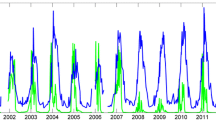Abstract
The metabolic rates (oxygen uptake, ammonia excretion, phosphate excretion) of epipelagic marine zooplankton have been expressed as a function of body mass (dry, carbon, nitrogen and phosphorus weights) and habitat temperature, using the multiple-regression method. Zooplankton data used for this analysis are from phylogenetically mixed groups (56 to 143 species, representing 7 to 8 phyla, body mass range: 6 orders of magnitude) from various latitudes (habitat temperature range:-1.4° to 30°C). The results revealed that 84 to 96% of variation in metabolic rates is due to body mass and habitat temperature. Among the various body-mass units, the best correlation was provided by carbon and nitrogen units for all three metabolic rates. Oxygen uptake, ammonia excretion and phosphate excretion are all similar in terms of body-mass effect, but differ in terms of temperature effect. With carbon or nitrogen body-mass units, calculated Q10 values are 1.82 to 1.89 for oxygen uptake, 1.91 to 1.93 for ammonia excretion and 1.55 for phosphate excretion. The effects of body mass and habitat temperature on the metabolic quotients (O:N, N:P, O:P) are insignificant. The present results for oxygen-uptake rate vs body mass do not differ significantly from those reported for general poikilotherms by Hemmingsen and for crustaceans by Ivleva at a comparable temperature (20°C). The importance of a body-mass measure for meaningful comparison is suggested by the evaluation of the habitat-temperature effect between mixed taxonomic groups and selected ones. Considering the dominant effects of body mass and temperature on zooplankton metabolic rates, the latitudinal gradient of community metabolic rate for net zooplankton in the ocean is estimated, emphasizing the non-parallelism between community metabolic rates and the standing stock of net zooplankton.
Similar content being viewed by others
Literature cited
Banse, K.: Mass-scaled rates of respiration and intrinsic growth in very small invertebrates. Mar. Ecol. Prog. Ser. 9, 281–297 (1982)
Beers, J. R.: Studies on the chemical composition of the major zoopkankton groups in the Sargasso Sea off Bermuda. Limnol. Oceanogr. 11, 520–528 (1966)
Brett, J. R.: The respiratory metabolism and swimming performance of young sockeye salmon. J. Fish. Res. Bd Can. 21, 1183–1226 (1964)
Clarke, A.: Life in cold water: the physiological ecology of polar marine ectotherms. Oceanogr. mar. Biol. A. Rev. 21, 341–453 (1983)
Clutter, R. I. and G. H. Theilacker: Ecological efficiency of a pelagic mysid shrimp; estimates from growth, energy budget, and mortality studies. Fish. Bull. U.S. 69, 93–115 (1971)
Conover, R. J.: Transformation of organic matter. In: Marine ecology. Vol. IV. Dynamics, pp 221–499. Ed. by O. Kinne. Chichester: John Wiley & Sons 1978
Corner, E. D. S., C. B. Cowey and S. M. Marshall: On the nutrition and metabolism of zooplankton. V. Feeding efficiency of Calanus finmarchicus. J. mar. biol. Ass. U.K., 47, 259–270 (1967)
Corner, E. D. S. and A. G. Davies: Plankton as a factor in the nitrogen and phosphorus cycles in the sea. Adv. mar. Biol. 9, 101–204 (1971)
DeVries, A. L. and J. T. Eastman: Physiology and ecology of notothenioid fishes of the Ross Sea. Jl R. Soc. N.Z. 11, 329–340 (1981)
Ekman, S.: Zoogeography of the sea, 417 pp. London: Sidgwick & Jackson 1967
Foxton, P.: The distribution of the standing crop of zooplankton in the Southern Ocean. ‘Discovery’ Rep. 28, 191–236 (1956)
Harrison, W. G.: Nutrient regeneration and primary production in the sea. In: Primary productivity in the sea, pp 433–460. Ed. by P. G. Falkowski. New York and London: Plenum Press 1980
Heinrich, A. K.: On the tropical plankton communities in the western Pacific. J. Cons. int. Explor. Mer 33, 45–52 (1969)
Hemmingsen, A. M.: Energy metabolism as related to body size and respiratory surfaces, and its evolution. Rep. Steno meml Hosp. 9, 1–110 (1960)
Holeton, G. F.: Metabolic cold adaptation of polar fish: fact or artifact? Physiol Zoöl. 47, 137–152 (1974)
Ikeda, T.: Nutritional ecology of marine zooplankton. Mem. Fac. Fish. Hokkaido Univ. 22, 1–97 (1974)
Ikeda, T.: Metabolic activity of larval stages of Antarctic krill, Antarctic. J. U. S. 16, 161–162 (1981)
Ikeda, T., E. Hing Fay, S. A. Hutchinson and G. M. Boto: Ammonia and inorganic phosphate excretion by zooplankton from inshore waters of the Great Barrier Reef, Queensland. I. Relationship between excretion rates and body size. Aust. J. mar. Freshwat. Res 33, 55–70 (1982)
Ikeda, T. and A. W. Mitchell: Oxygen uptake, ammonia excretion and phosphate excretion by krill and other Antarctic zooplankton in relation to their body size and chemical composition. Mar. Biol. 71, 283–298 (1982)
Ikeda, T. and S. Motoda: Estimated zooplankton production and their ammonia excretion in the Kuroshio and adjacent seas. Fish. Bull. U.S. 76, 357–367 (1978a)
Ikeda, T. and S. Motoda: Zooplankton production in the Bering Sea calculated from 1956–1970 Oshoro Maru data. Mar. Sci. Comms 4, 329–346 (1978b)
Ikeda, T. and H. R. Skjoldal: The effect of laboratory conditions on the extrapolation of experimental measurements to the ecology of marine zooplankton. VI. Changes in physiological activities and biochemical components of Acetes sibogae australis and Acartia australis after capture. Mar. Biol. 58, 285–293 (1980)
Ivleva, I. V.: The dependence of crustacean respiration rate on body mass and habitat temperature. Int. Revue ges. Hydrobiol. 65, 1–47 (1980)
Johannes, R. E.: Phosphorus excretion and body size in marine animals: microzooplankton and nutrient regeneration. Science, N.Y. 146, 923–924 (1964)
Kawamura, A.: Food and feeding ecology in the southern sei whale. Scient. Rep. Whales Res. Inst. Tokyo 26, 1–144 (1974)
Klekowski, R. A.: Cartesian diver microrespirometry for aquatic animals. Polskie Archwm Hydrobiol. 18, 93–114 (1971)
Lasker, R.: Feeding, growth, respiration and carbon utilization of a euphausiid crustacean. J. Fish. Res. Bd Can. 23, 1291–1317 (1966)
Laws, E. A. and J. W. Archie: Appropriate use of regression analysis in marine biology. Mar. Biol. 65, 13–16 (1981)
Marshall, S. M.: Respiration and feeding in copepods. Adv. mar. Biol. 11, 57–120 (1973)
Marshall, S. M., A. G. Nicholls and A. P. Orr: On the biology of Calanus finmarchicus. VI. Oxygen consumption in relation to environmental conditions. J. mar biol. Ass. U.K. 20, 1–27 (1935)
McLaren, I. A.: Effects of temperature on growth of zooplankton and the adaptive value of vertical migration. J. Fish. Res. Bd Can. 20, 685–727 (1963)
Omori, M. and T. Ikeda: Methods in marine zooplankton ecology, 332 pp. New York: John Wiley & Sons 1984
Prosser, C. L.: Oxygen: respiration and metabolism. In: Comparative animal physiology, pp 153–197. Ed. by C. L. Prosser and F. A. Brown, Jr. Philadelphia and London: W. B. Saunders Co. 1961
Reid, J. L., E. Brinton, A. Fleminger, E. L. Venrick and J. A. McGowan: Ocean circulation and marine life. In: Advances in oceanography, pp 65–130. Ed. by H. Charnock and G. Deacon. New York: Plenum Publishing Corporation 1978
Schmidt-Nielsen, K.: Locomotion: energy cost of swimming, flying, and running. Science, N.Y. 177, 222–228 (1972)
Strickland, J. D. H. and T. R. Parsons: A practical handbook of seawater analysis, 2nd ed. Bull. Fish. Res. Bd Can. 167, 1–310 (1972)
Sverdrup, H. J., M. W. Johnson and R. H. Fleming: The oceans: their physics, chemistry and general biology, 1087 pp. New York: Prentice-Hall Inc. 1942
Taniguchi, A.: Phytoplankton-zooplankton relationships in the western Pacific Ocean and adjacent seas. Mar. Biol. 21, 115–121 (1973)
Torres, J. J. and J. J. Childress: Relationship of oxygen consumption to swimming speed in Euphausia pacifica. I. Effects of temperature and pressure. Mar. Biol. 74, 79–86 (1983)
Torres, J. J., J. J. Childress and L. B. Quetin: A pressure vessel for the simultaneous determination of oxygen consumption and swimming speed in zooplankton. Deep-Sea Res. 29, 631–639 (1982)
Van Der Spoel, S. and R. P. Heyman: A comparative atlas of zooplankton. Biological patterns in the oceans, 186 pp. Berlin: Springer-Verlag 1983
Vidal, J.: Physioecology of zooplankton. IV. Effects of phytoplankton concentration, temperature, and body size on the net production efficiency of Calanus pacificus. Mar. Biol. 56, 203–211 (1980)
Vidal, J. and T. E. Whitledge: Rates of metabolism of planktonic crustaceans as related to body weight and temperature of habitat. J. Plankton Res. 4, 77–84 (1982)
Vinogradov, A. P.: The elementary chemical composition of marine organisms. Mem. Sears Fdn mar. Res. 1953 (2), 1–647 (1953)
Vinogradov, M. E.: Vertical distribution of the oceanic zooplankton, 339 pp. Jerusalem: Israel Program for Scientific Translations 1968
Wimpenny, R. S.: The plankton of the sea, 426 pp. London: Faber & Faber Ltd. 1966
Winberg, G. G.: Methods for the estimation of production of aquatic animals, 175 pp. New York: Academic Press 1971
Zeuthen, E.: Body size and metabolic rate in the Animal Kingdom with special regard to the marine microfauma. C. r. Trav. Lab. Carlsberg (Sér. chim.) 26, 17–161 (1947)
Zeuthen, E.: Oxygen uptake as related to body size in organisms. Q. Rev. Biol. 28, 1–12 (1953)
Author information
Authors and Affiliations
Additional information
Communicated by G. F. Humphrey, Sydney
Rights and permissions
About this article
Cite this article
Ikeda, T. Metabolic rates of epipelagic marine zooplankton as a function of body mass and temperature. Mar. Biol. 85, 1–11 (1985). https://doi.org/10.1007/BF00396409
Accepted:
Issue Date:
DOI: https://doi.org/10.1007/BF00396409




